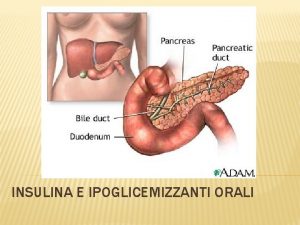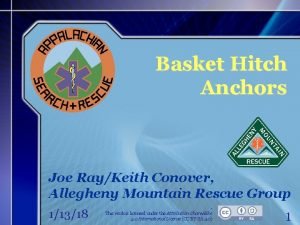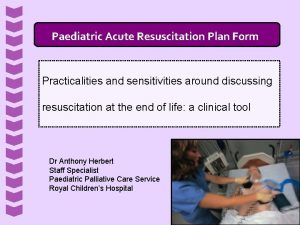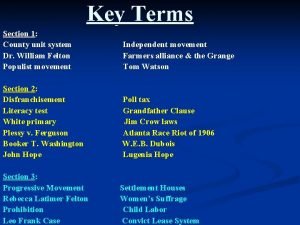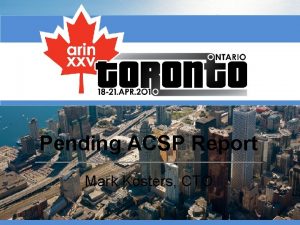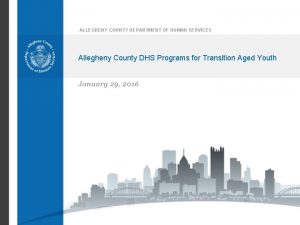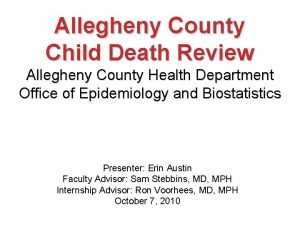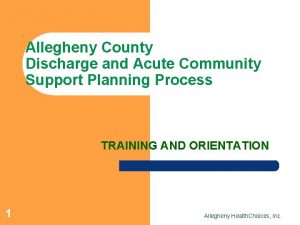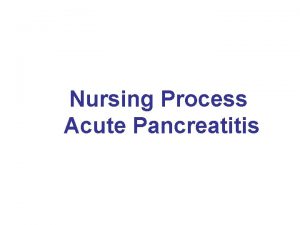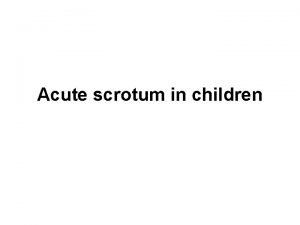Allegheny County Acute Community Support Plan ACSP Process











- Slides: 11

Allegheny County Acute Community Support Plan (ACSP) Process MRSAP Steering Committee August 21, 2009 1

Acute Community Support Plan (ACSP) • Comprehensive support and resource planning process that is driven by a blending of the consumer’s, family’s, and treatment/service coordination team’s preferences, recommendations, and competencies. • Promotes higher levels of accountability • Uses external facilitator to encourage new thinking and provide objective review • Supported by web-based application to ensures all parties working with the same information • Modeled after the Mayview CSP discharge process 2

Key Characteristics of a CSP • Shared responsibility between County, MCO, IP team, community providers, consumer, and other supports • A disciplined and highly facilitated process using a nonaffiliated facilitator and recorder • Consumers get to where they need to be rather than following a continuum of care • Avoid ‘one size fits all’ approach to discharge planning • An incremental approach to discharge planning • Recovery focused and person-centered 3

Why do an ACSP: Outcomes • Positive consumer outcomes • Understanding and respecting the client’s choices is critical for longterm success • Greater satisfaction • Improved quality of life • Greater ownership in discharge process • Positive system outcomes • • • Improved collaboration among key stakeholders Higher level of accountability Services/supports match consumer needs Reduced inpatient recidivism Initiated to improve consumer outcomes and not just to increase access to resources 4

Acute Inpatient Discharge Process: Overview Level 3 Level 2 Level 1 Acute CSP Discharge Planning Facilitated by ACSP Coordinator Disposition Meetings Acute Inpatient Multi-Disciplinary Treatment Team Discharge Planning Facilitated by County Disposition Coordinator Multi-Disciplinary Treatment Team on Inpatient Unit 5

ACSP Eligibility Criteria (Draft) To be eligible, consumer must meet one of the following criterion: • 4 inpatient admissions in last 12 months • 2 prior state hospitalizations or any continued state hospital stay greater than 2 years in duration • An acute inpatient hospitalization greater than 90 days in duration in past 12 months • EAC, RTFA, LTSR treatment in the last 12 months • Has had disposition meeting within the last 12 months • Consensus that the ACSP process is necessary to assure the development of a plan that promotes recovery, safety and community stability. 6

Acute CSP Discharge Process • The County Disposition Coordinator and inpatient treatment team can refer to the ACSP process when ACSP criteria is met. • ACSP Facilitator introduces process to consumer • If consumer is not ready to participate in the ACSP process, the Facilitator works to the engage consumer • Assessments are completed • CART completes Peer and Family assessments • SW completes Clinical Assessment • Facilitated ACSP meetings are conducted according to phases • Information Gathering and Options • Resource Coordination and Transition • Final Plan 7

ACSP Participants • Consumer and anyone the consumer invites • Family members of the consumer or representatives of the family • Members of the hospital treatment team and community provider (Service Coordinator or CTT is critical) • MHA Advocate • County ACSP Coordinator • MCO representative • Peer support • The facilitator and recorder 8

Current Status • Piloted at the TRU in Fall 2008 • A phased roll-out started in January 2009 that included seven training sessions which occurred from January through July 2009 • All hospitals (11) and service coordination units (9) in Allegheny County have received training • Currently 14 consumers are in some part of ACSP process, 3 of which are transition age. • There have been 2 discharges from the ACSP process with an average of 4 meetings each. • Barriers 9

What we’re working on… • Psychiatrist attendance in meetings • Providing community supports including service coordination and housing to insure desired match • Continuous education to providers about supports in the community • A conflict resolution process is in development 10

ACSP: Other Supports and Activities • The ACSP Advisory Committee meets every other month. Participants include Allegheny County OBH, DRN, MHA, PSAN, St. Clair Hospital, Mercy Behavioral Health, WPIC, OMSHAS, CCBHO and AHCI. • Weekly meetings occur between Allegheny County OBH and AHCI to discuss referrals to the process. • Pamphlets have been developed to guide families and consumers through the process 11
 Fosforilasi ritirato dal commercio
Fosforilasi ritirato dal commercio Adobe-clean
Adobe-clean Matp allegheny county
Matp allegheny county North allegheny alumni
North allegheny alumni North allegheny tiger id portal
North allegheny tiger id portal Potomac section wv
Potomac section wv North allegheny school district map
North allegheny school district map Basket hitch anchor
Basket hitch anchor Acute resuscitation plan form
Acute resuscitation plan form Cholecystitis nursing care plan
Cholecystitis nursing care plan What are the signal words
What are the signal words How did the county unit system support segregation?
How did the county unit system support segregation?
